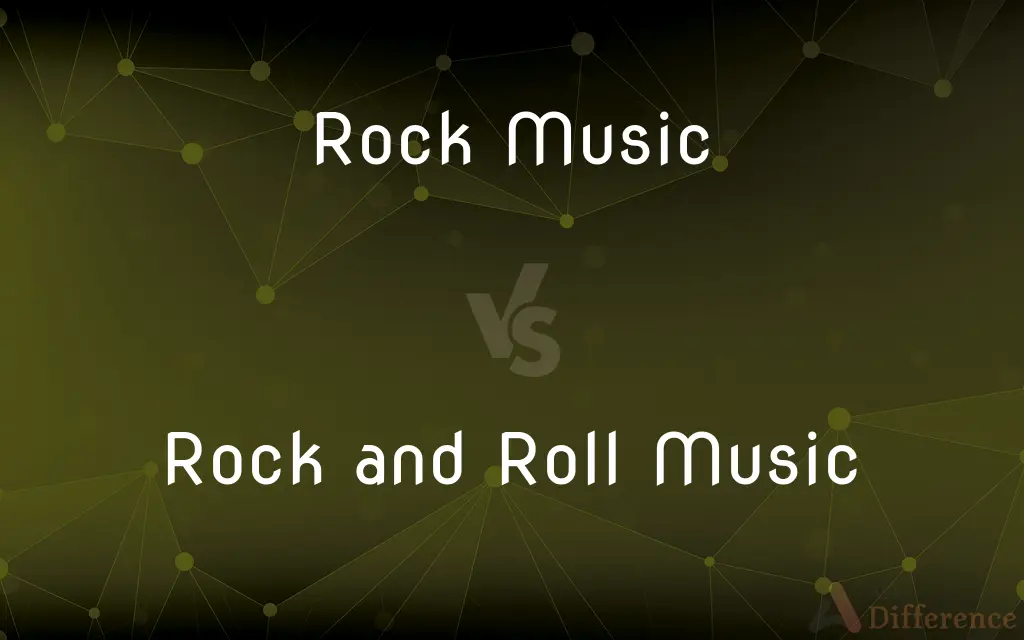Rock Music vs. Rock and Roll Music — What's the Difference?
By Tayyaba Rehman & Urooj Arif — Published on February 9, 2024
Rock Music is a broad genre evolved from Rock and Roll, which is more specific and characterized by its rhythm and blues roots.

Difference Between Rock Music and Rock and Roll Music
Table of Contents
ADVERTISEMENT
Key Differences
Rock Music encompasses a wide range of styles that evolved from the 1960s onwards, incorporating elements from other genres and often characterized by electric guitars, bass guitar, drums, and strong rhythms. Rock and Roll Music, originating in the 1950s, is a subset of Rock Music, characterized by its blend of blues, country, and rhythm and blues, with a strong backbeat. Rock Music, with its diverse styles, can range from the softer sounds of folk rock and pop rock to the heavier sounds of hard rock and metal, showcasing a broader spectrum of musical expression. Rock and Roll Music, on the other hand, tends to maintain a more consistent structure and sound, often centered around the 12-bar blues progression and a simpler, more repetitive rhythm. While Rock Music can incorporate a variety of lyrical themes and complex arrangements, Rock and Roll Music typically focuses on themes of love, rebellion, and freedom, with straightforward, catchy melodies. The evolution of Rock Music from Rock and Roll Music has led to the former being seen as a more encompassing genre, with Rock and Roll Music often celebrated as the foundation that laid the groundwork for the diverse world of Rock Music.
Comparison Chart
Era
Emerged in the 1960s, evolving continuously to present.
Originated in the 1950s, with its peak during that time.
Musical Characteristics
Diverse styles, complex arrangements.
Simple, repetitive rhythms, 12-bar blues progression.
Instrumentation
Electric guitars, bass, drums, often keyboards.
Primarily electric guitar, bass, drums.
Lyrical Themes
Wide range, including social issues, personal emotions.
Love, rebellion, freedom, with straightforward messages.
ADVERTISEMENT
Influence and Evolution
Draws from various genres, constantly evolving.
Laid the foundation for Rock Music, less evolution.
Compare with Definitions
Rock Music
A genre characterized by its electric guitar-led sound and diverse influences.
The band's latest album epitomizes Rock Music with its innovative guitar riffs.
Rock and Roll Music
A rhythmic music genre originating in the 1950s, characterized by a strong backbeat.
The festival's lineup celebrates the roots of Rock and Roll Music with classic hits and dancing.
Rock Music
Features a wide range of vocal styles, from melodic singing to aggressive shouting.
His vocal range adds a unique dimension to their Rock Music, from soft ballads to hard-hitting anthems.
Rock and Roll Music
Often features simple chord progressions and a focus on the electric guitar.
The song captures the spirit of Rock and Roll Music with its infectious guitar solo and upbeat tempo.
Rock Music
Often associated with themes of rebellion, social commentary, and personal expression.
The song's powerful lyrics and driving beats are a classic example of Rock Music's impact.
Rock and Roll Music
Retains a nostalgic appeal, reminding fans of the genre's golden era in the 1950s.
The band's sound is a nod to Rock and Roll Music's heyday, with a modern twist that keeps it fresh.
Rock Music
Encompasses various sub-genres, from alternative to metal, defined by its rebellious spirit.
Their sound has reshaped Rock Music, blending punk energy with lyrical depth.
Rock and Roll Music
Emphasizes live performance, with an energy that connects with audiences of all ages.
Their live show was a tribute to Rock and Roll Music, bringing generations together through music.
Rock Music
Defined by its emphasis on live performance and band dynamics.
The live concert captured the essence of Rock Music, with its raw energy and crowd interaction.
Rock and Roll Music
Known for its danceable beats and catchy melodies, often centered around love and fun.
Their rendition of the Rock and Roll Music classic had everyone on their feet and dancing.
Common Curiosities
What defines Rock and Roll Music?
Rock and Roll Music is a style of music that emerged in the 1950s, known for its danceable rhythms, simple structures, and themes of love and freedom.
How did Rock Music evolve from Rock and Roll Music?
Rock Music evolved from Rock and Roll in the 1960s, incorporating a wider range of musical influences and exploring more complex themes and compositions.
Are Rock Music and Rock and Roll Music the same?
While Rock and Roll Music is a subset of Rock Music, Rock Music encompasses a broader range of styles and complexities.
What instruments are typical in Rock Music?
Rock Music commonly features electric guitars, bass guitar, drums, and sometimes keyboards and other instruments.
Is Rock and Roll Music still popular?
Rock and Roll Music retains a nostalgic appeal and is celebrated for its influence on subsequent music genres.
How do the themes in Rock Music and Rock and Roll Music differ?
Rock Music often explores a wide range of themes, including social and political issues, while Rock and Roll Music traditionally focuses on themes of love, fun, and freedom.
What is Rock Music?
Rock Music is a broad genre that includes a variety of styles, characterized by the use of electric guitars, strong rhythms, and a focus on live performance.
Did Rock and Roll Music face any controversy?
Yes, in its early days, Rock and Roll Music was often seen as rebellious and faced criticism from conservative circles.
How do live performances differ between Rock Music and Rock and Roll Music?
Both prioritize live performance, but Rock Music concerts can range from intimate acoustic sets to large-scale rock shows, while Rock and Roll Music often emphasizes danceability and audience interaction.
Can Rock Music be acoustic?
Yes, Rock Music can include acoustic elements, especially in sub-genres like folk rock or unplugged performances.
What instruments are key in Rock and Roll Music?
Rock and Roll Music typically focuses on electric guitars, bass, and drums, with a less frequent use of other instruments.
How has Rock Music influenced other genres?
Rock Music has influenced numerous other genres, from hip-hop and electronic music to pop, by contributing elements of its style and attitude.
Can Rock Music include electronic elements?
Yes, Rock Music can incorporate electronic elements, especially in genres like alternative rock or industrial rock.
Is dancing a key component of Rock and Roll Music?
Yes, Rock and Roll Music is known for its danceable beats and was often associated with dance styles of the 1950s.
Are there any cultural movements associated with Rock Music?
Rock Music has been associated with various cultural movements, including the counterculture of the 1960s and 70s.
Share Your Discovery

Previous Comparison
JPEG vs. MPEG
Next Comparison
ArrayList in Java vs. LinkedList in JavaAuthor Spotlight
Written by
Tayyaba RehmanTayyaba Rehman is a distinguished writer, currently serving as a primary contributor to askdifference.com. As a researcher in semantics and etymology, Tayyaba's passion for the complexity of languages and their distinctions has found a perfect home on the platform. Tayyaba delves into the intricacies of language, distinguishing between commonly confused words and phrases, thereby providing clarity for readers worldwide.
Co-written by
Urooj ArifUrooj is a skilled content writer at Ask Difference, known for her exceptional ability to simplify complex topics into engaging and informative content. With a passion for research and a flair for clear, concise writing, she consistently delivers articles that resonate with our diverse audience.
















































